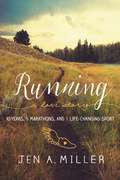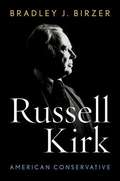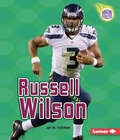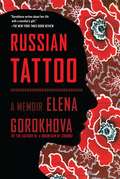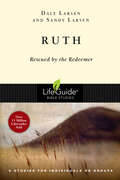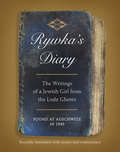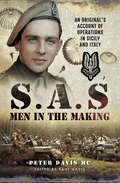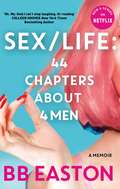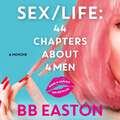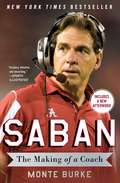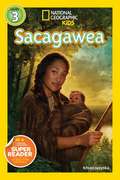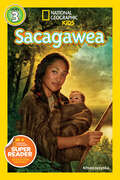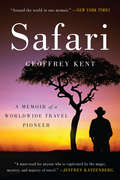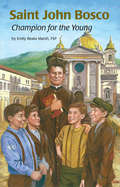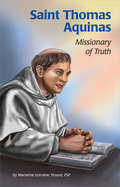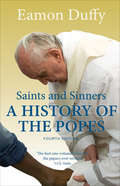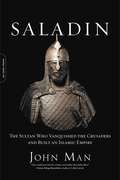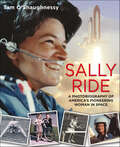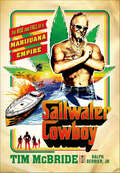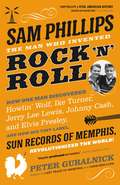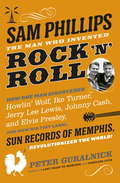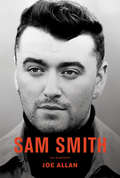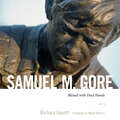- Table View
- List View
Running: 10 Years, 5 Marathons, and 1 Life-Changing Sport
by Jen A. MillerJen Miller has fallen in and out of love, but no man has been there for her the way running has.In Running: A Love Story, Jen tells the story of her lifelong relationship with running with wit, thoughtfulness, and brutal honesty. Jen first laces up her sneakers in high school, when, like many people, she sees running as a painful part of conditioning for other sports. But when she discovers early in her career as a journalist that it helps her clear her mind, focus her efforts, and achieve new goals, she becomes hooked for good.Jen, a middle-of-the-pack but tenacious runner, hones her skill while navigating relationships with men that, like a tricky marathon route, have their ups and downs, relying on running to keep her steady in the hard times. As Jen pushes herself toward ever-greater challenges, she finds that running helps her walk away from the wrong men and learn to love herself while revealing focus, discipline, and confidence she didn't realize she had.Relatable, inspiring, and brutally honest, Running: A Love Story, explores the many ways that distance running carves a path to inner peace and empowerment by charting one woman's evolution in the sport.
Russell Kirk: American Conservative
by Bradley J. BirzerEmerging from two decades of the Great Depression and the New Deal and facing the rise of radical ideologies abroad, the American Right seemed beaten, broken, and adrift in the early 1950s. Although conservative luminaries such as T. S. Eliot, William F. Buckley Jr., Leo Strauss, and Eric Voegelin all published important works at this time, none of their writings would match the influence of Russell Kirk's 1953 masterpiece The Conservative Mind. This seminal book became the intellectual touchstone for a reinvigorated movement and began a sea change in Americans' attitudes toward traditionalism.
Russell Wilson (Amazing Athletes Ser.)
by Jon M FishmanWhen Russell Wilson played for the University of Wisconsin, many people thought he was too short to be a starting quarterback in the National Football League (NFL). But he proved these doubters wrong. This Seattle Seahawks quarterback led his team to victory in his very first season, winning the 2014 Super Bowl. Football fans cheer his passing power and leadership skills. Find out more about Russell's journey to the top.
Russian Tattoo: A Memoir
by Elena GorokhovaAn exquisite portrait of mothers and daughters that reaches from Cold War Russia to modern-day New Jersey, from the author of A Mountain of Crumbs--the memoir that "leaves you wanting more" (The Daily Telegraph, UK).In A Mountain of Crumbs Elena Gorokhova describes coming of age behind the Iron Curtain and leaving her mother and her Motherland for a new life in the United States. Now, in Russian Tattoo, Elena learns that the journey of an immigrant is filled with everyday mistakes, small humiliations, and a loss of dignity. Cultural disorientation comes in the form of not knowing how to eat a hamburger, buy a pair of shoes, or catch a bus. But through perseverance and resilience, Elena gradually adapts to her new country. With the simultaneous birth of her daughter and the arrival of her Soviet mother, who comes to the US to help care for her granddaughter and stays for twenty-four years, it becomes the story of a unique balancing act and a family struggle. Russian Tattoo is a poignant memoir of three generations of strong women with very different cultural values, all living under the same roof and battling for control. Themes of separation and loss, grief and struggle, and power and powerlessness run throughout this story of growing understanding and, finally, redemption. "Gorokhova writes about her life with a novelist's gift," says The New York Times, and her latest offering is filled with empathy, insight, and humor.
Rywka's Diary: The Writings of a Jewish Girl from the Lodz Ghetto
by Anita Friedman"A work of elegant translation and painstaking contextualization by Holocaust scholars and surviving family members that sharpens the historical and spiritual lens through which it's absorbed." —Chicago TribuneThe newly discovered diary of a Polish teenager in the Lodz ghetto during World War II—originally published by Jewish Family & Children’s Services of San Francisco, now revised, illustrated, and beautifully designedAfter more than seventy years in obscurity, the diary of a teenage girl during the Holocaust has been revealed for the first time. Rywka’s Diary is at once an astonishing historical document and a moving tribute to the many ordinary people whose lives were forever altered by the Holocaust. At its heart, it is the diary of a girl named Rywka Lipszyc who detailed the brutal conditions that Jews in the Lodz ghetto, the second largest in Poland, endured under the Nazis: poverty, hunger and malnutrition, religious oppression, and, in Rywka’s case, the death of her parents and siblings. Handwritten in a school notebook between October 1943 and April 1944, the diary ends literally in mid-sentence. What became of Rywka is a mystery. A Red Army doctor found her notebook in Auschwitz after its liberation in 1945 and took it back with her to the Soviet Union.Rywka’s Diary is also a moving coming-of-age story, in which a young woman expresses her curiosity about the world and her place in it and reflects on her relationship with God—a remarkable affirmation of her commitment to Judaism and her faith in humanity. Interwoven into this carefully translated diary are photographs, news clippings, maps, and commentary from Holocaust scholars and the girl’s surviving relatives, which provide an in-depth picture of both the conditions of Rywka's life and the mysterious end to her diary.Moving and illuminating, told by a brave young girl whose strong and charismatic voice speaks for millions, Rywka’s Diary is an extraordinary addition to the history of the Holocaust and World War II.
S.A.S Men in the Making: An Original's Account of Operations in Sicily and Italy
by Peter DavisPeter Davis was the youngest officer in the SAS during World War II. In his autobiographical account, he reveals the nave enthusiasm he felt when he joined the Unit, his fears and trepidation during training, and the horror at what he later experienced during his first operations in the liberation of Sicily and Italy. This is his story.It explores the difficulty of a young, inexperienced officer leading older and seasoned soldiers. It tells of mistakes a 'rookie' can make and of how listening, learning and ultimately earning respect made him the skilful leader he ultimately became. During later operations he was awarded the Military Cross.Through it all the enigmatic figure of Paddy Mayne looms large. At times irrational, aggressive, and often drunk, he was always a born leader able to instil obedience and respect. Where he led, men followed.This autobiographical account was written shortly after the end of the War, using diaries written at the time. It is possibly the last, untold, first-hand account of a time of chaos, of horror and of the camaraderie of the men of the SAS.
SEX/LIFE: Now a series on Netflix
by BB EastonOne woman's secret journal completely changes her marriage in this hilarious and biting memoir - the inspiration for the Netflix Original Series.School psychologists aren't supposed to write books about sex. Doing so would be considered 'unethical' and 'a fireable offense'. Lucky for you, ethics was never my strong suit.Sex/Life: 44 Chapters About 4 Men is a laugh-out-loud funny and brutally honest look at female sexuality, as told through the razor-sharp lens of domesticated bad girl BB Easton. No one and nothing is off limits as BB revisits the ex-boyfriends - a sadistic tattoo artist, a punk rock parolee, and a heavy metal bass player - that led her to finally find true love with a straight-laced, drop-dead-gorgeous . . . accountant.After settling down and starting a family with her perfectly vanilla 'husbot', Ken, BB finds herself longing for the reckless passion she had in her youth. She begins to write about these escapades in a secret journal, just for fun, but when Ken starts to act out the words on the pages, BB realizes that she might have stumbled upon the holy grail of behaviour modification techniques.The psychological dance that ensues is nothing short of hilarious as BB wields her journal like a blowtorch, trying to light a fire under her cold, distant partner. Sometimes it works, sometimes it doesn't, but in the end, BB learns that the man she was trying so hard to change was perfect for her all along.
SEX/LIFE: Now a series on Netflix
by BB EastonThe inspiration for the hit Netflix series Sex/LifeOne woman's secret journal completely changes her marriage in this hilarious and biting memoir. School psychologists aren't supposed to write books about sex. Doing so would be considered 'unethical' and 'a fireable offense'. Lucky for you, ethics was never my strong suit.Sex/Life: 44 Chapters About 4 Men is a laugh-out-loud funny and brutally honest look at female sexuality, as told through the razor-sharp lens of domesticated bad girl BB Easton. No one and nothing is off limits as BB revisits the ex-boyfriends - a sadistic tattoo artist, a punk rock parolee, and a heavy metal bass player - that led her to finally find true love with a straight-laced, drop-dead-gorgeous . . . accountant.After settling down and starting a family with her perfectly vanilla 'husbot', Ken, BB finds herself longing for the reckless passion she had in her youth. She begins to write about these escapades in a secret journal, just for fun, but when Ken starts to act out the words on the pages, BB realizes that she might have stumbled upon the holy grail of behaviour modification techniques.The psychological dance that ensues is nothing short of hilarious as BB wields her journal like a blowtorch, trying to light a fire under her cold, distant partner. Sometimes it works, sometimes it doesn't, but in the end, BB learns that the man she was trying so hard to change was perfect for her all along.
Saban: The Making of a Coach
by Monte BurkeAn instant New York Times bestseller—the “insidery, detailed, and absorbing” (Sports Illustrated) biography of Nick Saban, the polarizing University of Alabama football coach who not only transformed the college game, but might also be the best ever at winning.As the head coach of the University of Alabama’s football team, Nick Saban is perhaps the most influential—and polarizing—man in the sport. His program-building vision has delivered packed stadiums, rabid fans, legions of detractors, countless NFL draft picks, and a total of four national championships, including three in the last five years. He is the only coach in the college football’s modern era (since 1936) to win national championships at two different schools. Monte Burke’s Saban—the first major biography of the man who has come to epitomize the game—presents this towering figure with a never-before-seen human depth. Though a great deal is known about Nick Saban the coach, not much is known about Nick Saban the man. Little is written about his early climb through the coaching ranks as an assistant in college and in the NFL, or his head-coaching stints at Michigan State and Louisiana State and his struggles as a pro coach with the Miami Dolphins. Through unprecedented interviews with more than 250 friends, coworkers, rivals, former players, and others, Burke reveals the defining moments of the coach’s life, including the beginning of his recruiting career at age ten; his dramatic departures from three different high-profile football teams; and the building of championship programs at Louisiana State and Alabama. In Saban, “Burke has written a winning, definitive portrait of a fascinating character…. A no-holds-barred glimpse into the quest for perfection” (Publishers Weekly).
Sacagawea
by Kitson JazynkaExplore one of the most recognized figures in American history with this biography of Sacagawea. Kids will learn about her crucial role in the Lewis and Clark expedition and her influential legacy.
Sacagawea (Readers Bios)
by Kitson JazynkaExplore one of the most recognized figures in American history with this biography of Sacagawea. Kids will learn about her crucial role in the Lewis and Clark expedition and her influential legacy. The level 3 text provides accessible, yet wide-ranging, information for independent readers.
Sachin Tendulkar - Meri Atmakatha: सचिन तेंदुलकर - मेरी आत्मकथा
by Sachin Tendulkarक्रिकेट के इतिहास में सबसे ज़्यादा रन बनाने वाले सचिन तेंदुलकर शिखर पर 24 अद्भुत वर्ष बिताने के बाद 2013 में रिटायर हो गए। अब तक के सबसे मशहूर भारतीय क्रिकेटर सचिन को भारत रत्न पुरस्कार - भारत का सर्वोच्च नागरिक सम्मान उनके रिटायरमेंट के दिन मिला। अब सचिन तेंदुलकर अपनी खुद की उल्लेखनीय कहानी बता रहे हैं- 16 साल की उम्र में पहले टेस्ट से लेकर उनके 100वें अंतरराष्ट्रीय शतक तक और उस भावनात्मक अंतिम विदाई तक, जिसने उनके देश को थाम सा दिया था। जब मुंबई के एक शरारती बच्चे की अतिरिक्त ऊर्जा को क्रिकेट की और मोड़ा गया, तो परिणाम स्कूली बल्लेबाज़ी के रिकॉर्डतोड़ कीर्तिमान के रूप में सामने आए, जिससे एक ऐतिहासिक क्रिकेट करियर शुरू हुआ। जल्द ही सचिन तेंदुलकर भारतीय बल्लेबाज़ी की बुनियाद बन गए और क्रिकेट को समर्पित देश के दीवाने लोग उनके खेल को ग़ौर से देखने लगे। किसी क्रिकेटर से कभी इतनी ज़्यादा उम्मीदें नहीं की गईं; किसी क्रिकेटर ने कभी इतने उच्च स्तर पर इतने लंबे समय तक और इतनी बढ़िया शैली में प्रदर्शन नहीं किया- उन्होंने किसी भी दूसरे खिलाड़ी से ज़्यादा रन और शतक बनाए हैं, टेस्ट मैचों में भी और एक दिवसीय मैचों में भी। उनकी मशहूर शख़्सियत के बावजूद, सचिन तेंदुलकर हमेशा बहुत निजी इंसान रहे हैं, अपने परिवार तथा देश के प्रति समर्पित। वे पहली बार अपने व्यक्तिगत जीवन के बारे में विस्तार से रोचक जानकारी दे रहे हैं और एक अनूठे खेल जीवन का सच्चा व सरस वर्णन पेश कर रहे हैं।
Safari: A Memoir of a Worldwide Travel Pioneer
by Geoffrey KentIn Safari, Abercrombie & Kent’s founder takes readers on a global tour, sharing his best-kept secrets and the story of his success and his life.Foreword by DreamWorks CEO Jeffrey Katzenberg“An edge-of-your-seat reading experience, kept especially engaging by [Kent's] warm personality, sense of humor, and keen behind-the-scenes-of-building-a-business stories.” —ParadeGeoffrey Kent had nothing but an East African shilling and an old Land Rover when he pioneered the luxury tent safari business in 1962 with his parents in Nairobi. Today Kent takes thousands of adventurers, hungry for extraordinary and life-changing experiences, to the planet’s wildest frontiers.In his gripping memoir, this “Indiana Jones—meets—James Bond” entrepreneur recounts his phenomenal journey. Kent’s life reads like a work of fiction: growing up barefoot in the African bush, riding his motorcycle across the continent, and ultimately becoming the most sought-after travel professional in the world. Safari: A Memoir of a Worldwide Travel Pioneer is a breathtaking and exhilarating trip to some of the most exotic and stunning locations on earth.
Saint John Bosco: Champion for the Young
by Wayne Alfano Emily Beata Marsh FSPIntroduce readers ages 9-12 to a saint known worldwide for his work with youth and who understood how to help children both love God and have fun, using their youthful energy for good.
Saint Thomas Aquinas: Missionary of Truth
by Cathy Morrison Marianne Lorraine Trouvé FSPIntelligent, wealthy, and well-connected, Thomas left it all behind to become a missionary of God's truth, joining the newly formed Dominicans.
Saints and Sinners: A History of the Popes; Fourth Edition
by Eamon DuffyThe latest edition of &“the most comprehensive single-volume history of the popes,&” updated to cover the election of Pope Francis (Sunday Telegraph). This engrossing book, from a professor of the history of Christianity at Cambridge, encompasses the extraordinary story of the papacy, from its beginnings to the present day, as empires rose and fell around it. This new edition covers the unprecedented resignation of Benedict XVI, and the historic election of the first Argentinian pope. Praise for the earlier editions: &“Duffy enlivens the long march through church history with anecdotes that bring the different pontiffs to life…Saints and Sinners is a remarkable achievement.&”—The Times (London) &“A distinguished text…offering plenty of historical facts and sobering, valuable judgments.&”—TheNew York Times Book Review &“Will fascinate anyone wishing to better understand the history of the Catholic Church and the forces that have shaped the role of the papacy.&”—Christian Century
Saladin: The Sultan Who Vanquished the Crusaders and Built an Islamic Empire
by John ManSaladin remains one of the most iconic figures of his age. As the man who united the Arabs and saved Islam from Christian crusaders in the twelfth century, he is the Islamic world's preeminent hero. A ruthless defender of his faith and brilliant leader, he also possessed qualities that won admiration from his Christian foes.But Saladin is far more than a historical hero. Builder, literary patron, and theologian, he is a man for all times, and a symbol of hope for an Arab world once again divided. Centuries after his death, in cities from Damascus to Cairo and beyond, to the Arabian Peninsula and the Gulf, Saladin continues to be an immensely potent symbol of religious and military resistance to the West. He is central to Arab memories, sensibilities, and the ideal of a unified Islamic state.John Man charts Saladin's rise to power, his struggle to unify the warring factions of his faith, and his battles to retake Jerusalem and expel Christian influence from Arab lands. Saladin explores the life and enduring legacy of this champion of Islam while examining his significance for the world today.
Sally Ride: A Photobiography of America's Pioneering Woman in Space
by Tam O'ShaughnessyYears before millions of Americans tuned in to watch her historic space flight aboard the Challenger in 1983, Sally Ride stayed up late to watch Neil Armstrong become the first person to walk on the moon. The next morning, she woke up to win her first round singles match at a national junior tennis tournament.Sally Ride: A Photobiography of America's Pioneering Woman Astronaut, is an intimate journey from her formative years to her final moments. Before she was an astronaut, Sally was a competitive tennis player who excelled at the game to such an extent that Billie Jean King told her she could play on the pro circuit. Before she earned a Ph.D. in physics, she was called an underachiever by her high school classmates. After her first historic space flight-she took a second in 1984-Sally continued to break ground as an inspirational advocate for space exploration, public policy, and science education, who fought gender stereotypes and opened doors for girls and women in all fields during the second half of the twentieth century.This vivid photobiography, written by Sally's life, writing, and business partner, Tam O'Shaughnessy, offers an intimate and revealing glimpse into the life and mind of the famously private, book-loving, tennis-playing physicist who made history.
Saltwater Cowboy: The Rise and Fall of a Marijuana Empire
by Ralph Berrier Jr. Tim McBride“A wild and entertaining true story by one of the biggest pot haulers in American history . . . Tim McBride’s tale of excess is a thrill to read.” —Bruce Porter, New York Times–bestselling author of BlowIn 1979, Wisconsin native Tim McBride hopped into his Mustang and headed south. He was twenty-one, and his best friend had offered him a job working as a crab fisherman in Chokoloskee Island, a town of fewer than 500 people on Florida’s Gulf Coast. Easy of disposition and eager to experience life at its richest, McBride jumped in with both feet.But this wasn’t a typical fishing outfit. McBride had been unwittingly recruited into a band of smugglers—middlemen between a Colombian marijuana cartel and their distributors in Miami. His elaborate team comprised fishermen, drivers, stock houses, security—seemingly all of Chokoloskee Island was in on the operation. As McBride came to accept his new role, tons upon tons of marijuana would pass through his hands.Then the federal government intervened in 1984, leaving the crew without a boss and most of its key players. McBride, now a veteran smuggler, was somehow spared. So when the Colombians came looking for a new middle-man, they turned to him.McBride became the boss of an operation that was ultimately responsible for smuggling 30 million pounds of marijuana. A self-proclaimed “Saltwater Cowboy,” he would evade the Coast Guard for years, facing volatile Colombian drug lords and risking betrayal by romantic partners until his luck finally ran out.A tale of crime and excess, Saltwater Cowboy is the gripping memoir of one of the biggest pot smugglers in American history.
Sam Phillips: The Man Who Invented Rock 'n' Roll
by Peter GuralnickThe author of the critically acclaimed Elvis Presley biography Last Train to Memphis brings us the life of Sam Phillips, the visionary genius who singlehandedly steered the revolutionary path of Sun Records. The music that he shaped in his tiny Memphis studio with artists as diverse as Elvis Presley, Ike Turner, Howlin' Wolf, Jerry Lee Lewis, and Johnny Cash, introduced a sound that had never been heard before. He brought forth a singular mix of black and white voices passionately proclaiming the vitality of the American vernacular tradition while at the same time declaring, once and for all, a new, integrated musical day. With extensive interviews and firsthand personal observations extending over a 25-year period with Phillips, along with wide-ranging interviews with nearly all the legendary Sun Records artists, Guralnick gives us an ardent, unrestrained portrait of an American original as compelling in his own right as Mark Twain, Walt Whitman, or Thomas Edison.
Sam Phillips: The Man Who Invented Rock 'n' Roll
by Peter GuralnickRock 'n' roll was born in rural Alabama, 1923, in the form of Sam Phillips, the youngest son of a large family living in a remote colony called the Lovelace Community. His father had a gift for farming, which was brought to an end by the Depression. His mother picked guitar and showed the kind of forbearance that allowed her to name her son after the doctor who delivered him drunk and then had to be put to bed himself. And yet from these unprepossessing origins, in 1951 Phillips made what is widely considered to be the first rock 'n' roll record, Ike Turner and Jackie Brenston's 'Rocket 88'. Just two years later a shy eighteen-year-old kid with sideburns, fresh out of high school, wandered into his recording studio to make a record 'for his mother', secretly hoping that it might somehow get him noticed. His name was Elvis Presley. Elvis's success, and the subsequent triumph of rock 'n' roll, was initially propelled to an almost astonishing degree by a limited number of releases by Carl 'Blue Suede Shoes' Perkins, Johnny Cash and Jerry Lee Lewis - all from this tiny, one-man label. An engaging mix of biography and anecdote, Peter Guralnick's book brilliantly recreates one shining moment in the history of popular culture. And Sam Phillips was the man who brought it all about.
Sam Smith E Pub
by Joe AllanSam Smith's debut album, In the Lonely Hour, sold four million copies and won four 2015 Grammy awards. The young, soulful singer has massive crossover appeal, with his album going gold or platinum around the world and his touching honesty about loneliness, love, and his own sexuality coming through in both his music and interviews. While the media largely painted Smith as an "overnight success story," Sam Smith: The Biography shows the hard work that Smith put in for over a decade. Joe Allan is the author of 5 Seconds of Summer: The Unauthorized Biography and Chris Pratt: The Biography.
Sam Smith: The Biography
by Joe AllanSam Smith's debut album, In the Lonely Hour, sold four million copies and won four 2015 Grammy awards. In 2016, he won an Oscar for Best Original Song. The young, soulful singer has massive crossover appeal, with his touching honesty about loneliness, love, and his own sexuality coming through in both his music and interviews. While the media largely painted Smith as an "overnight success story," Sam Smith: The Biography shows the hard work that Smith put in for over a decade.Joe Allan is the author of 5 Seconds of Summer: The Unauthorized Biography and Chris Pratt: The Biography.
Samuel M. Gore: Blessed with Tired Hands
by Barbara GaunttBorn in Coolidge, Texas, Samuel Marshall Gore was the sixth of ten children born to a Baptist preacher and a mother described as “an angel.” From early childhood, Samuel Gore remembers enjoying making things, and gives credit to his mother and grandmother for his interest in art. Gore went on to be an art teacher and professor for more than fifty years, mostly at Mississippi College in Clinton, Mississippi. He has shown work in exhibitions and galleries for more than forty years. In 2012 the Mississippi Institute of Arts and Letters honored him with its Lifetime Achievement Award. In the first part of this volume, Barbara Gauntt traces how a concept in the mind of the artist comes to execution. Gore uses sketches on scraps of paper to inform studies in clay, as the piece Christ, Fulfillment of the Law begins to take its inspired shape. The project, expected to take about a year, lasts nearly two as Gore works to capture the constantly changing image forming in his mind. The 12' x 8' bronze, bas relief sculpture, a sister piece to Moses, Deliverer of the Law commissioned for the Mississippi College School of Law, moves from a small work area in the sculptor’s home to a shop on his property. There he builds the full-size piece on an armature of wood, foam board, and netting covered with clay. From chaos arises the beauty of detailed faces and a work of art that tells a story. The second section of the book covers the artist’s career from the late 1940s into the twenty-first century. Superb photographs of both two- and three-dimensional pieces show the artist’s diverse style and talent. Gore says that he “want[s] people to put their hands on [his] sculpture” because that is how he experiences his art. Gore sees no end in sight to his work. Moses started preaching at the age of eighty, so Gore figures that he is just getting started. This volume features detailed information about all of the artwork included; an interview with Samuel Gore in which the artist discusses his career, technique, and philosophy; a timeline of his life and career; and a foreword by noted Mississippi artist and former student, Wyatt Waters.
